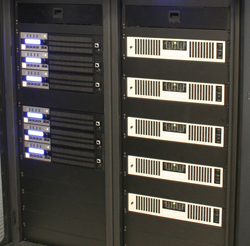
Pink Noise & Metering Issues
Pink noise is the most real-world of the test signals. It’s also the most difficult to measure accurately and refine to a single number. Sine wave clipping is trivially easy to observe on an oscilloscope.
Pink noise clipping has to be pretty severe to see it on a scope, so I had to rely on the metering of each amplifier. That’s where things become gray.
Consider the following:
1) Is clipping even possible? Most modern amplifiers have algorithms that prevent clipping. How fast does it kick in? How much “over” does the amplitude have to be before clipping suppression activates?
2) How often does the clip light have to flash before I declare that I have reached clipping? Once? Fairly often? Continuous illumination? There is some interpretation required here.
3) Once I have decided that I’ve reached clipping, what is the measured voltage? Even with an expensive True- RMS voltmeter with both digital readout and bar graph, it is a judgment call to assign a single number to something that has a 12 dB difference between its peak and RMS value. It’s another judgment call.
The clipping indicators of three different brands are bound to use different criteria for each of these. And no, you can’t detect the onset of clipping by listening.
In part 1, I showed how the peak program meter (PPM) is designed to ignore clipping that is likely inaudible (6-8 dB). For these and other reasons, I wouldn’t use the pink noise voltage and power ratings for comparing various brands of amplifiers. Errors of 3 dB or more could be expected, and in this power range that could be hundreds of watts.
As proof that all of this matters, just look at the open circuit voltage comparison between the sine wave and pink noise for each amplifier. The sine wave has a 3 dB crest factor and the pink noise a 12 dB crest factor. That’s a 9 dB differential.
Yet when I calculate the dB difference between sine and noise output for each amplifier, I only get the expected 9 dB for the QSC. That tells me that there is a difference in the metering of the three amplifiers.
If you look at the ratings matrix it appears that the QSC output voltage and power is significantly lower than the other two with pink noise, but this is obviously due at least in part to differences in metering. I could have easily produced a higher voltage from the QSC using a different visual criteria for clip. That’s why I hate “one number” ratings when taken at face value.
Things Amplifiers Hate
There are two conditions that none of these amplifiers like – low crest factor signals and 2-ohm loads. The continuous sine wave testing was by far the most revealing with regard to how much power the amplifier (and the electrical outlet) could source. I had to reset the circuit breaker numerous times during the sine wave testing into lower impedances with two channels driven.
I should mention that all of the amplifiers recovered nicely from circuit breaker trips. Once they powered back up they resumed working, and the PCcontrolled models re-established communications. All of the amplifiers have internal breakers, and none of them tripped during any of the tests.
None of these amplifiers could maintain their output voltage into 2 ohms with a sine wave source. The results varied so dramatically that I removed that data from the matrix. They sort of work at 2 ohms with pink noise, although I believe that the voltage limitations were due more to the amplifier’s “smarts” than due to their electrical current limitations.
The designers are trying to protect their amplifier and loudspeaker. They are trying to keep you from “running with scissors” when you insist on overloading your amplifier to get more watts.
None of the amplifiers cared if the load was resistive or reactive. That is a very good thing for a commercial power amplifier, and something that hi-fi amplifiers often have a problem with.
Burst Testing Results
These amplifiers get their largest power ratings from tone burst testing. Ironically, that was the easiest signal for all of the amplifiers to pass.
